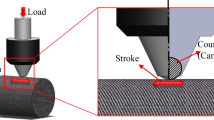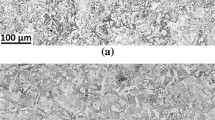Abstract
Additive manufacturing (AM) has emerged as an alternative tool to overcome the challenges in conventionally processed metallic components. It is gaining wide acceptability because of the superior properties of the manufactured components compared to their wrought processed counterparts. Among the available AM processed materials, austenitic stainless steel 316L is widely explored wherein an excellent strength-ductility trade-off has been reported. However, the mechanisms underlying fracture toughness of AM stainless steel 316L vis-à-vis wrought processed stainless steel 316L material are not yet explored. The present investigation is aimed at examining the mechanisms accountable for the fracture toughness of AM processed stainless steel 316L. The specimens are produced by two different AM techniques namely, selective laser melting (SLM) and wire arc additive manufacturing (WAAM). A wrought processed stainless steel 316L was used as a control material for comparison. Three-point bending tests were carried out on fatigue pre-cracked single edge notched specimens and crack initiation fracture toughness was evaluated. Digital image correlation was used for strain analysis and to monitor crack propagation. The SLM manufactured sample has shown higher fracture toughness whereas WAAM has exhibited nearly the same fracture toughness when compared to the wrought processed stainless steel 316L sample. Microstructure of fractured samples consists of a significantly higher twin density and a higher propensity of dislocation slip was observed in the SLM sample than the other two. It has been argued that a very fine cellular structure, minimized process-induced defects, enhanced twin density led to promising toughness in the SLM processed stainless steel 316L.










Similar content being viewed by others
References
Antolovich SD, Singh B (1970) Observations of martensite formation and fracture in TRIP steels. Metall Mater Trans B 1:3463–3465. https://doi.org/10.1007/BF03037885
Auzoux Q, Allais L, Caës C, Monnet I, Gourgues AF, Pineau A (2010) Effect of pre-strain on creep of three AISI 316 austenitic stainless steels in relation to reheat cracking of weld-affected zones. J Nucl Mater 400:127–137. https://doi.org/10.1016/j.jnucmat.2010.02.021
Bahl S, Suwas S, Ungàr T, Chatterjee K (2017) Elucidating microstructural evolution and strengthening mechanisms in nanocrystalline surface induced by surface mechanical attrition treatment of stainless steel. Acta Mater 122:138–151. https://doi.org/10.1016/j.actamat.2016.09.041
Bahl S, Mishra S, Yazar KU, Kola IR, Chatterjee K, Suwas S (2019) Non-equilibrium microstructure, crystallographic texture and morphological texture synergistically result in unusual mechanical properties of 3D printed 316L stainless steel. Addit Manuf 28:65–77. https://doi.org/10.1016/j.addma.2019.04.016
Bai S, Perevoshchikova N, Sha Y, Wu X (2019) The effects of selective laser melting process parameters on relative density of the AlSi10Mg parts and suitable procedures of the archimedes method. Appl Sci 9:583. https://doi.org/10.3390/app9030583
Chakkravarthy V, Jerome S (2020) Printability of multiwalled SS 316L by wire arc additive manufacturing route with tunable texture. Mater Lett 260:126981. https://doi.org/10.1016/j.matlet.2019.126981
DebRoy T, Wei HL, Zuback JS, Mukherjee T, Elmer JW, Milewski JO, Beese AM, Wilson-Heid A, De A, Zhang W (2018) Additive manufacturing of metallic components—process, structure and properties. Prog Mater Sci 92:112–224. https://doi.org/10.1016/j.pmatsci.2017.10.001
El-Tahawy M, Jenei P, Kolonits T, Han G, Park H, Choe H, Gubicza J (2020) Different evolutions of the microstructure, texture, and mechanical performance during tension and compression of 316L stainless steel. Metall Mater Trans A 51:3447–3460. https://doi.org/10.1007/s11661-020-05782-5
Frómeta D, Parareda S, Lara A, Molas S, Casellas D, Jonsén P, Calvo J (2020) Identification of fracture toughness parameters to understand the fracture resistance of advanced high strength sheet steels. Eng Fract Mech 229:106949. https://doi.org/10.1016/j.engfracmech.2020.106949
Frómeta D, Cuadrado N, Rehrl J, Suppan C, Dieudonné T, Dietsch P, Calvo J, Casellas D (2021) Microstructural effects on fracture toughness of ultra-high strength dual phase sheet steels. Mater Sci Eng A 802:140631. https://doi.org/10.1016/j.msea.2020.140631
Gokuldoss PK, Kolla S, Eckert J (2017) Additive manufacturing processes: selective laser melting, electron beam melting and binder jetting-selection guidelines. Materials 10:1–11. https://doi.org/10.3390/ma10060672
Herzog D, Seyda V, Wycisk E, Emmelmann C (2016) Additive manufacturing of metals. Elsevier, Cham
Jhavar S, Jain NK, Paul CP (2014) Development of micro-plasma transferred arc (μ-PTA) wire deposition process for additive layer manufacturing applications. J Mater Process Technol 214:1102–1110. https://doi.org/10.1016/j.jmatprotec.2013.12.016
Jiang Y, Xu R, Tan Z, Ji G, Fan G, Li ZZ, Xiong DB, Guo Q, Li ZZ, Zhang D (2019) Interface-induced strain hardening of graphene nanosheet/aluminum composites. Carbon 146:17–27. https://doi.org/10.1016/j.carbon.2019.01.094
Jin W, Zhang C, Jin S, Tian Y, Wellmann D, Liu W (2020) Wire arc additive manufacturing of stainless steels: a review. Appl Sci 10:1563. https://doi.org/10.3390/app10051563
Jung HY, Choi SJ, Prashanth KG, Stoica M, Scudino S, Yi S, Kühn U, Kim DH, Kim KB, Eckert J (2015) Fabrication of Fe-based bulk metallic glass by selective laser melting: a parameter study. Mater Des 86:703–708. https://doi.org/10.1016/j.matdes.2015.07.145
Jyotheender KS, Srivastava C (2021) Correlating the five-parameter grain boundary character distribution and corrosion behavior of zinc-carbon nanotube composite coatings. Metall Mater Trans A 52:364–377. https://doi.org/10.1007/s11661-020-06070-y
Kaoumi D, Liu J (2018) Deformation induced martensitic transformation in 304 austenitic stainless steel: in-situ vs. ex-situ transmission electron microscopy characterization. Mater Sci Eng A 715:73–82. https://doi.org/10.1016/j.msea.2017.12.036
Karpagaraj A, Baskaran S, Arunnellaiappan T, Kumar NR (2020) A review on the suitability of wire arc additive manufacturing (WAAM) for stainless steel 316. In: AIP Conference Proceedings. American Institute of Physics Inc., p 050001
Kong D, Dong C, Ni X, Zhang L, Li X (2020) Cellular size dependence on the strength of additively manufactured austenitic stainless steel. Mater Lett 279:128524. https://doi.org/10.1016/j.matlet.2020.128524
Li Z, Voisin T, McKeown JT, Ye J, Braun T, Kamath C, King WE, Wang YM (2019) Tensile properties, strain rate sensitivity, and activation volume of additively manufactured 316L stainless steels. Int J Plast 120:395–410. https://doi.org/10.1016/j.ijplas.2019.05.009
Lodhi MJK, Deen KM, Greenlee-Wacker MC, Haider W (2019) Additively manufactured 316L stainless steel with improved corrosion resistance and biological response for biomedical applications. Addit Manuf 27:8–19. https://doi.org/10.1016/j.addma.2019.02.005
Ma X, Huang C, Moering J, Ruppert M, Höppel HW, Göken M, Narayan J, Zhu Y (2016) Mechanical properties of copper/bronze laminates: role of interfaces. Acta Mater 116:43–52. https://doi.org/10.1016/j.actamat.2016.06.023
MacDonald E, Wicker R (2016) Multiprocess 3D printing for increasing component functionality. Science. https://doi.org/10.1126/science.aaf2093
Montero-Sistiaga ML, Godino-Martinez M, Boschmans K, Kruth JP, Van Humbeeck J, Vanmeensel K (2018) Microstructure evolution of 316L produced by HP-SLM (high power selective laser melting). Addit Manuf 23:402–410. https://doi.org/10.1016/j.addma.2018.08.028
Ngo TD, Kashani A, Imbalzano G, Nguyen KTQ, Hui D (2018) Additive manufacturing (3D printing): a review of materials, methods, applications and challenges. Composite B 143:172–196. https://doi.org/10.1016/j.compositesb.2018.02.012
Park J, Lee K, Sung H, Kim YJ, Kim SKS, Kim SKS (2019) J-integral fracture toughness of high-Mn steels at room and cryogenic temperatures. Metall Mater Trans A 50:2678–2689. https://doi.org/10.1007/s11661-019-05200-5
Prashanth KG, Eckert J (2017) Formation of metastable cellular microstructures in selective laser melted alloys. J Alloy Compd 707:27–34. https://doi.org/10.1016/j.jallcom.2016.12.209
Prashanth KG, Scudino S, Klauss HJ, Surreddi KB, Löber L, Wang Z, Chaubey AK, Kühn U, Eckert J (2014) Microstructure and mechanical properties of Al-12Si produced by selective laser melting: effect of heat treatment. Mater Sci Eng A 590:153–160. https://doi.org/10.1016/j.msea.2013.10.023
Rodrigues TA, Duarte V, Miranda RM, Santos TG, Oliveira JP (2019) Current status and perspectives on wire and arc additive manufacturing (WAAM). Materials 12:1121. https://doi.org/10.3390/ma12071121
Scudino S, Liu G, Prashanth KG, Bartusch B, Surreddi KB, Murty BS, Eckert J (2009) Mechanical properties of Al-based metal matrix composites reinforced with Zr-based glassy particles produced by powder metallurgy. Acta Mater 57:2029–2039. https://doi.org/10.1016/j.actamat.2009.01.010
Scudino S, Unterdörfer C, Prashanth KG, Attar H, Ellendt N, Uhlenwinkel V, Eckert J (2015) Additive manufacturing of Cu-10Sn bronze. Mater Lett 156:202–204. https://doi.org/10.1016/j.matlet.2015.05.076
Shamsujjoha M, Agnew SR, Fitz-Gerald JM, Moore WR, Newman TA (2018) High strength and ductility of additively manufactured 316L stainless steel explained. Metall Mater Trans A 49:3011–3027. https://doi.org/10.1007/s11661-018-4607-2
Sreedhar SA, Ravindran S, Shankar G, Suwas S, Narasimhan R (2021) Fracture mechanism and toughness of a rolled magnesium alloy under dynamic loading. Acta Mater 202:350–365. https://doi.org/10.1016/j.actamat.2020.10.059
Sun Z, Tan X, Tor SB, Chua CK (2018) Simultaneously enhanced strength and ductility for 3D-printed stainless steel 316L by selective laser melting. NPG Asia Mater 10:127–136. https://doi.org/10.1038/s41427-018-0018-5
Suryawanshi J, Prashanth KG, Scudino S, Eckert J, Prakash O, Ramamurty U (2016) Simultaneous enhancements of strength and toughness in an Al-12Si alloy synthesized using selective laser melting. Acta Mater 115:285–294. https://doi.org/10.1016/j.actamat.2016.06.009
Suryawanshi J, Prashanth KG, Ramamurty U (2017a) Mechanical behavior of selective laser melted 316L stainless steel. Mater Sci Eng A 696:113–121. https://doi.org/10.1016/j.msea.2017.04.058
Suryawanshi J, Prashanth KG, Ramamurty U (2017b) Tensile, fracture, and fatigue crack growth properties of a 3D printed maraging steel through selective laser melting. J Alloy Compd 725:355–364. https://doi.org/10.1016/j.jallcom.2017.07.177
Takaki S, Nakatsu H, Tokunaga Y (1993) Effects of austenite grain size on ε martensitic transformation in Fe-15mass%Mn alloy. Mater Trans JIM 34:489–495. https://doi.org/10.2320/matertrans1989.34.489
Ummethala R, Karamched PS, Rathinavelu S, Singh N, Aggarwal A, Sun K, Ivanov E, Kollo L, Okulov I, Eckert J, Prashanth KG (2020) Selective laser melting of high-strength, low-modulus Ti–35Nb–7Zr–5Ta alloy. Materialia. https://doi.org/10.1016/j.mtla.2020.100941
Ungár T (2004) Microstructural parameters from X-ray diffraction peak broadening. Scr Mater 51:777–781. https://doi.org/10.1016/j.scriptamat.2004.05.007
Wang YM, Voisin T, McKeown JT, Ye J, Calta NP, Li Z, Zeng Z, Zhang Y, Chen W, Roehling TT, Ott RT, Santala MK, Depond PJ, Matthews MJ, Hamza AV, Zhu T (2018) Additively manufactured hierarchical stainless steels with high strength and ductility. Nat Mater 17:63–70. https://doi.org/10.1038/NMAT5021
Wang L, Xue J, Wang Q (2019a) Correlation between arc mode, microstructure, and mechanical properties during wire arc additive manufacturing of 316L stainless steel. Mater Sci Eng A 751:183–190. https://doi.org/10.1016/j.msea.2019.02.078
Wang X, Muñiz-Lerma JA, Attarian Shandiz M, Sanchez-Mata O, Brochu M (2019b) Crystallographic-orientation-dependent tensile behaviours of stainless steel 316L fabricated by laser powder bed fusion. Mater Sci Eng A 766:138395. https://doi.org/10.1016/j.msea.2019.138395
Wang C, Liu TG, Zhu P, Lu YH, Shoji T (2020a) Study on microstructure and tensile properties of 316L stainless steel fabricated by CMT wire and arc additive manufacturing. Mater Sci Eng A 796:140006. https://doi.org/10.1016/j.msea.2020.140006
Wang Z, Ummethala R, Singh N, Tang S, Suryanarayana C, Eckert J, Prashanth KG (2020b) Selective laser melting of aluminum and its alloys. Materials 13:1–67. https://doi.org/10.3390/ma13204564
Wang Z, Xie M, Li Y, Zhang W, Yang C, Kollo L, Eckert J, Prashanth KG (2020c) Premature failure of an additively manufactured material. NPG Asia Mater 12:1–10. https://doi.org/10.1038/s41427-020-0212-0
Wang Z, Tang SY, Scudino S, Ivanov YP, Qu RT, Wang D, Yang C, Zhang WW, Greer AL, Eckert J, Prashanth KG (2021) Additive manufacturing of a martensitic Co–Cr–Mo alloy: towards circumventing the strength–ductility trade-off. Addit Manuf 37:101725. https://doi.org/10.1016/j.addma.2020.101725
Wen DX, Long P, Li JJ, Huang L, Zheng ZZ (2020) Effects of linear heat input on microstructure and corrosion behavior of an austenitic stainless steel processed by wire arc additive manufacturing. Vacuum 173:109131. https://doi.org/10.1016/j.vacuum.2019.109131
Xiong L, You ZS, Lu L (2017) Fracture behavior of an austenitic stainless steel with nanoscale deformation twins. Scr Mater 127:173–177. https://doi.org/10.1016/j.scriptamat.2016.09.012
Xiong L, You ZS, Qu SD, Lu L (2018) Fracture behavior of heterogeneous nanostructured 316L austenitic stainless steel with nanotwin bundles. Acta Mater 150:130–138. https://doi.org/10.1016/j.actamat.2018.02.065
Ye C, Lu G, Peng X, Hou S, Zhou J, Ni L (2020) Microstructure and mechanical properties of the 316 stainless steel nuclear grade experimental component made by wire and arc additive manufacturing. Proc Inst Mech Eng C 234:4258–4267. https://doi.org/10.1177/0954406220920692
Zhao C, Wang Z, Li D, Kollo L, Luo Z, Zhang W, Gokuldoss K, Prashanth KG (2021) Selective laser melting of Cu–Ni–Sn: a comprehensive study on the microstructure, mechanical properties, and deformation behavior. Int J Plast 138:102926. https://doi.org/10.1016/j.ijplas.2021.102926
Acknowledgements
The authors are very thankful to the Mechanical testing laboratory, Dept. of Materials Engineering, Indian Institute of Science, Bangalore for successfully conducting mechanical tests. Acknowledgment is also given specifically to Kantharaj (Facility in-charge, Mechanical testing lab), Ken Kaushal (Intern, NIT Surathkal), and Dhaneshwaran M (Student, Atria Institute of Technology, Bangalore) as they have also assisted in this work during the conduction of experiments. The authors are also grateful to Prof. Rajeev Ranjan to allow XRD measurement in his lab facility. K.G.P acknowledges the funding through European Regional Development Grant via ASTRA6-6.
Author information
Authors and Affiliations
Corresponding author
Additional information
Publisher's Note
Springer Nature remains neutral with regard to jurisdictional claims in published maps and institutional affiliations.
Rights and permissions
About this article
Cite this article
Kumar, D., Jhavar, S., Arya, A. et al. Mechanisms controlling fracture toughness of additively manufactured stainless steel 316L. Int J Fract 235, 61–78 (2022). https://doi.org/10.1007/s10704-021-00574-3
Received:
Accepted:
Published:
Issue Date:
DOI: https://doi.org/10.1007/s10704-021-00574-3




